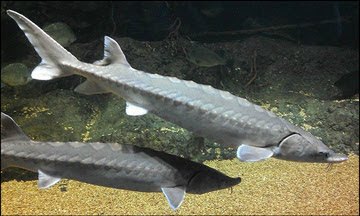Fishing Encouraged To Help Sturgeon's Genetic Diversity
 |
A hatchery program to restore white sturgeon above Grand Coulee Dam some 15 years ago was initially so successful that agencies are now turning to anglers to remove some of the offspring the program first produced.
That's because only a small number of parents produced all those baby sturgeon, prompting concerns that the sturgeon population in Lake Roosevelt will become dominated by the genetics of a few families.
And that's where anglers are coming to the rescue. In 2017, the Washington Department of Fish and Wildlife opened the first fishing season, allowing anglers to catch and retain sturgeon for the first time in 20 years. Fishing continued last summer; and in June, another white sturgeon fishing season opened on Lake Roosevelt for a third year.
"Before the fish get old enough to reproduce we need to thin them out, get their numbers down," Scott Bettin, a Bonneville Power Administration fisheries biologist, explained in a news release. "Some sturgeon could begin to produce at around 18 years of age, and that's just about where we are right now. We don't want the genes of just a few families to dominate the future."
Bill Baker, fisheries biologist for the Washington Department of Fish and Wildlife, told NW Fishletter that in the early 2000s, the population was listed under Canada's environmental laws, and a hatchery program began. Soon after, the Washington Department of Fish and Wildlife, and the Spokane and Colville tribes joined the effort, beginning their own program for hatchery supplementation in the mid-2000s. "It was far more successful than anyone would have guessed at the time," he said.
Baker said the sturgeon survived at much higher rates than anticipated, leading to a large number of sturgeon spawned from a small group of parents. "We were concerned about those over-represented year classes," he said. With so many adults now old enough to reproduce, fish managers don't want that group of over-produced fish to become parents, causing "a genetic swamping effect," he said.
Native to the Columbia River, sturgeon are the largest of freshwater fish. The prehistoric fish can live to be 100 years old, grow to 12 feet long, and weigh up to 1,000 pounds.
According to an article by the Northwest Power and Conservation Council, the Columbia River population was decimated by overfishing by 1899, but recovered somewhat after a few decades, with harvest increasing steadily in the 1970s and 1980s.
Hydroelectric dams have also impacted sturgeon by changing the speed and timing of river flows. Water temperatures, turbidity and depth are also important to healthy sturgeon populations.
Funded largely by the BPA, the hatchery programs stock up to 12,000 juvenile sturgeon in the lake each year. They are managed by the Spokane and Colville tribes, the Washington Department of Fish and Wildlife, and Canadian entities.
To ensure that more families are represented, the hatchery program began using some wild adult broodstock in 2010 for its fish source, Baker said. The eggs and larvae are taken to hatcheries and reared for a year before they are released back to the river.
In Canada, white sturgeon are listed as endangered under its Species at Risk Act. According to BPA, successful hatchery programs and the international Upper Columbia White Sturgeon Recovery Initiative helped avoid a listing for Lake Roosevelt's population in the U.S.


 Advertising
Advertising